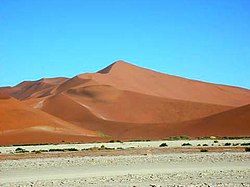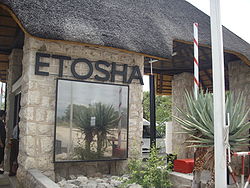This article needs additional citations for verification .(December 2010) |


Tourism in Namibia is a major industry, contributing N$7.2 billion (equal to US$ 390 million) to the country's gross domestic product. Annually, over one million travelers visit Namibia, with roughly one in three coming from South Africa, then Germany and finally the United Kingdom, Italy and France. The country is among the prime destinations in Africa and is known for ecotourism which features Namibia's extensive wildlife. [1]
Contents
- History
- Employment
- Rankings and evaluation
- Tourist destinations
- Windhoek
- Walvis Bay
- Swakopmund
- National Parks
- Kaokoveld
- Extreme sports
- The Namibia Tourism Board
- Trade associations
- Statistics
- See also
- References
- External links
In December 2010, Lonely Planet named Namibia 5th best tourist destination in the world in terms of value. [2]




